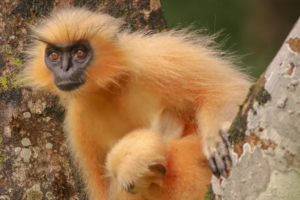PRELIMS BITS

Gee’s Golden Langur (Trachypithecus geei)
It is an endangered primate species endemic to a small region in western Assam, India, and the foothills of Bhutan’s Black Mountains. Known for its striking golden to cream-colored fur and black face, the golden langur is a flagship species for conservation in the Indo-Bhutan region.
Taxonomy & Discovery
- Scientific Name: Trachypithecus geei
- Common Names: Golden Langur, Gee’s Golden Langur
- Family: Cercopithecidae (Old World monkeys)
- Discovered: First described by E.P. Gee in 1956
Habitat & Distribution
- Geographic Range: Confined between the Manas and Sankosh rivers (east-west), the Brahmaputra River (south), and the Black Mountains of Bhutan (north).
- Elevation: From sea level up to 3,000 meters.
- Preferred Habitats: Subtropical and temperate broadleaf forests, including moist evergreen, semi-evergreen, riparian moist deciduous forests, and savannas.
- Key Protected Areas in India:
- Manas National Park
- Chakrashila Wildlife Sanctuary
- Raimona National Park
- Ripu and Chirang Reserve Forests
Population Status
- India (2020–2021 Survey): Estimated at 7,396 individuals, showing an increase from approximately 6,000 in 2008–09.
- Northern Sub-population: ~5,566 individuals in the western part of the Manas Biosphere Reserve.
- Southern Fragmented Population: ~1,830 individuals along the southern side of NH27.
Conservation Status
- IUCN Red List: Endangered (EN)
- CITES: Appendix I
- India: Schedule I of the Wildlife Protection Act, 1972
- Bhutan: Protected under the Forest and Nature Conservation Act, 1995
Physical Characteristics
- Weight: 9–12 kg
- Body Length: Males ~95 cm; Females ~89 cm
- Tail Length: Males ~98 cm; Females ~87 cm
- Distinct Features: Golden to cream-colored fur with seasonal variation; black, hairless face surrounded by a pale beard.
Behavior & Ecology
- Diet: Primarily herbivorous—consuming fruits, leaves, buds, flowers, and seeds.
- Social Structure: Live in groups ranging from 3 to 15 individuals; larger groups observed in degraded habitats.
- Reproduction: Breeding can occur year-round; gestation lasts about six months, typically resulting in a single offspring.
Conservation Challenges
- Habitat Fragmentation: Due to deforestation, agricultural expansion, and infrastructure development.
- Human-Wildlife Conflict: Electrocution from power lines and road accidents when langurs venture outside forests.
- Conservation Efforts:
- Plantation of fruit-bearing trees under MGNREGA in Assam’s Kakoijana Reserve Forest to reduce foraging outside protected areas.




